Mundane Astrology a Critique by James Braha
The following article is excerpted from James Braha’s most recent book, The Graha Sutras, Hermetician Press, 2022. They are used with the author’s permission.
Most mundane astrology, as practiced today, is completely useless.
[NOTE: The following sutra is confrontational and challenging to the core. Whenever a firmly held belief is questioned, the mind rebels. Contemplating that one of our most basic astrological beliefs could be nothing more than a myth is no fun.
Please try to keep an open mind, and remember the themes of this book: Think critically, constantly question, ceaselessly
search for truth, and go by your experience rather than by what others say.]
Chart for February 3, 1962; 11:30 AM, Miami, Florida, USA
(The same chart in India occurred at 11:54 AM in Bombay).

[NOTE: Please post the horoscope above on your wall for several weeks and look at it often, contemplating the information below. By dispelling astrological myths, we strengthen the world of astrology and give less ammunition to critics.]
Mundane astrology is concerned with the fate of nations and the world at large. There are no mundane astrologers in the world today who obtain anywhere near consistent accuracy. That’s right, none. If there were, they would be wealthy beyond belief, because they could predict giant financial fluctuations. They would also be famous the world over for obvious reasons.
And yet, when planets form rare combinations, astrologers always make dramatic and sweeping statements to anyone who will listen (and plenty do!). The so-called Harmonic Convergence—heralded as the harbinger of world peace—during August 1987, when eight planets formed a “grand trine” that was supposed to change the world, in fact produced nothing. A major shift from “hellish energies to harmony and cooperation” was supposed to result from the rare grand trine. According to Wikipedia, the “astrological interpretation” was that “The convergence is purported to have corresponded with a great shift in the earth’s energy from warlike to peace.” Blah blah blah. Despite the fact that the planets were so special and wonderful (trines in Western astrology represent the most positive and free flowing energies), the world for the 34 years following the convergence has been as warlike and quarrelsome as ever. Well, let’s be honest, it’s actually been worse. The convergence actually predates September 11th, 2001, the day of the New York City World Trade Center bombings, which dramatically worsened world conditions.
Likewise, the coming “New Age of Aquarius” that astrologers said was dawning in the 1960s and was going to bring an age of harmony and peace instead gave us endless wars and the worst global political situation I’ve ever seen. More nonsense.
The fact that in 2019 or 2020, no astrologer went on the news or alerted governments to a coming worldwide pandemic was no surprise to me. When YouTube astrology hosts asked me to predict when the pandemic would end, I always made the same joke, “That’s so easy. All you have to do is find the astrologers who predicted the pandemic and ask them for the answer.” Of course there were no astrologers who predicted it. No matter what anyone claims, no astrologer shouted from rooftops or tried to alert governments what was about to happen.
Every 5, 10, or 15 years astrologers announce that some planetary formation that hasn’t occurred in centuries will alter the world forever. The problem is that aside from some dramatic events in a few countries here and there, which happens constantly anyway, nothing happens. In my early years of practice, I was as fascinated and gullible as everyone else. Indeed, I even used the term “The New Age of Aquarius” in the Introduction of my first book, Ancient Hindu Astrology for the Modern Western Astrologer. I removed it in the 2020 Revised and Expanded edition, with a tinge of embarrassment I might add.
When I attended Vedic astrology conferences in the 1990s and beyond, I couldn’t wait to hear the annual lectures titled “Predictions for Next Year.” However, the prognostications always failed, especially the more dramatic ones. There was always a giant stock crash coming, a great political event, or some such exciting circumstance around the corner. And when, after five or ten years of making the same prediction, it finally succeeded, the astrologer would prominently announce it on his or her resume, ignoring all their previously failed predictions. Remember the old saying, “Even a stopped clock is accurate twice every 24 hours?”
Within a decade or two, after such disappointment, I became thoroughly skeptical of the worldly predictions astrologers based on rare planetary combinations.
The most famous and relatively accurate mundane astrologer in my lifetime was Jeane Dixon. She was very psychic and likely got more predictive information from her intuitive talents than from the planets. She used both, though, and maintained her own astrology newspaper column. During the 1960s and 1970s, Dixon made many famous and profound predictions, while also making just as many (actually more) that failed entirely. In 1956 she wrote that the president elected in 1960 would be a democrat who would die in office (JFK was elected in 1960 and was assassinated in 1963). However, in 1960, before the election, she reversed that forecast and said Richard Nixon would win the presidency.
She also wrongly claimed that cancer would be cured in 1967. Indeed, Wikipedia states that “John Allen Paulos, a mathematician at Temple University, coined the term “The Jeane Dixon Effect,” which references a tendency to promote a few correct predictions while ignoring a larger number of incorrect predictions.” This is exactly what I have noticed in the world of mundane astrology.
To this day, though, Jeane Dixon appears to have made more dramatically accurate predictions than anyone else, and has always had my respect. It’s true that Edgar Cayce made a phenomenal amount of accurate predictions, many more than Jeane Dixon or anyone else and without the huge number of wrong forecasts everyone else makes. However, he was not an astrologer. And, he wasn’t even a typical psychic or medium. According to biographies, early in life he had been knocked in the head with tremendous force (perhaps in his “third eye chakra”) and then began entering trances where he obtained all kinds of accurate medical knowledge and information about future events. Upon awakening from his trances, Cayce remembered nothing.
[NOTE: I grew up in North Miami Beach in the 1960s when Miami was an ordinary sized city, with nothing special whatsoever except its wonderful sunshine. Cayce, who died in 1945, predicted that Miami would one day become a giant international port with people flying in from all over the world. This was a rather far fetched prediction at the time, Miami being a small and quiet place, but it began taking shape in the 1970s and is now exactly what Cayce predicted it would be.]
I’m fully aware that to disparage mundane astrology is unpopular. However, facts are facts. Results speak for themselves. The best advice I can give, in order to save astrologers time and disappointment, is to seriously consider and ponder the planets on February 3rd, 1962. These positions are so bizarre and imbalanced that any astrologer with the slightest amount of knowledge would have expected something extraordinary, bizarre even, on that day or for the days, weeks, and months following. Indeed, there were no phenomenal results. Life continued the same as always.
On February 3rd, 1962, using sidereal positions for 12 Noon in Miami, Florida, Rahu occupied 24 degrees Cancer. The rest of the planets (not including Uranus, Neptune, and Pluto, which most Jyotishis ignore) were all, yes all, in Capricorn. The planetary degrees were as follows: Moon 3, Mars 8, Saturn 10, Sun 21, Venus 22, Ketu 24, Jupiter 25, Mercury 25. Yes, these 8 planets were all in one sign, in Capricorn. Nothing happened. The world did not end. There was no worldwide upheaval, revolution, or catastrophe. There was no huge change in business activity or corporations (ruled by Capricorn). Draw the chart. Post it on your wall. Think about it. Ponder it. Leave it up and think about it some more.
As if these bizarre planetary positions weren’t enough, the day in question is more astrologically incredible for Western astrologers and anyone using the outer planets. Using sidereal positions, Uranus was 6 degrees Leo, Neptune 20 degrees Libra, and Pluto at 16 degrees Leo. This means that Neptune tightly squared Sun, Mercury, Venus, and Jupiter, while Uranus formed quincunxes (150 degree aspects) with the Moon and Mars (quincunxes are bad aspects).
To be clear, I’m not saying that the planets on that day didn’t have any effect; just nothing remotely close to the kind of worldwide results that astrologers would expect or predict. And bear in mind that the positions on that day are profoundly more dramatic than all the other combinations astrologers rave about every 5 or 10 years.
Naturally, individual countries are affected by planetary positions because countries have birth times and therefore horoscopes. All horoscopes, personal or otherwise, are affected by transiting planets. Certainly some country like Pakistan or Sweden or Germany might have a major event within days of the planetary event. However, anyone expecting worldwide effects would have been sorely disappointed. Yet, it’s always worldly events that astrologers forecast during odd or exceptional planetary alignments.
One obvious problem with using planetary transits to predict worldwide effects is that there is no birth time for the world (that we are privy to), assuming the world’s birth time would help. The most we can do, from what I have seen, is note what happens when major planets enter signs. And even then, it’s difficult to know exactly what to predict. For example, the Covid pandemic occurred when Pluto entered sidereal Capricorn (February/March 2020). What does Pluto in Capricorn have to do with a deadly worldwide health issue? Does a pandemic occur every time Pluto enters that sign?
To be fair, and to consider every possibility, there was a major emergency in October 1962, eight months after the bizarre February planets, called the Cuban Missile Crisis, where the world came to the brink of nuclear war. Yes, eight months after one of the weirdest planetary alignments ever, a huge and frightening event that gripped the world occurred when Russia tried to install offensive nuclear missiles in Cuba, which from their view was perhaps considered a deterrent to a future U.S. invasion of the island nation—a country only 90 miles away from the U.S. mainland. Was this the result of those planets? Maybe. In fact, for argument’s sake, let’s say it is.
Even if this bizarre planetary alignment was the cause, though, is there anything about the February 1962 chart that could alert an astrologer to the nature of what would happen? Is there anything about that particular planetary arrangement that would tell us that a worldwide crisis would occur? And, that it would occur eight months later rather than in a few days or weeks? While I’m perfectly willing to accept that those planets are (possibly) connected to a monumental event that would happen much later, I’m not at all ready to say that an astrologer could use that chart to make an accurate prediction of what—and when—something would happen. Not at this point in our astrological understanding. Period. Full stop.
Please understand, I’m not saying that planets don’t have worldly effects. I am saying that in my lifetime I’ve not found any mundane astrologer able to produce anywhere near consistent predictive accuracy. Not 70%, not 50%, not 40%. Indeed, because of the incredibly poor track records of astrologers making mundane astrology predictions, my advice is that they should be ignored or, at best, seen as a curiosity.
[NOTE: In 1982, on my way to India, I stopped in Israel to visit a rabbi cousin of mine who ran a Yeshiva (orthodox Hebrew school). I spent a week there and met his young students. I had no knowledge of Jyotish at the time, but was obsessed with Western astrology, and was constantly discussing it. One day, a student said to me, “What do you know about February 3, 1962?” I was quite aware of the planets of that day and, stunned by his question, asked, “You’re not an astrologer, how do you know about that day?” He replied that it was his day of birth and that some New York astrologers had gotten the names of many children born that day in order to follow up on their lives. I was gobsmacked!
The student told me that by 1982, the results were that these 20-year- olds were plagued by vastly more troubles than their peers. They had much more drug addictions, behavioral problems, and other complexities than would be normally expected.]
Final Note: This is one of the longer sutras and is written for those rare astrologers who earnestly want to achieve predictive accuracy and are on a serious mission to find truth. For some who have already experienced and realized the terrible track record of mundane astrologers, and indeed most of mundane astrology itself, seeing these words in print may provide some comfort. Vashti, my wife, and I privately call what I have written “The Vashti Sutra,” because when I read it to her she was thrilled and grateful. She explained that for many years during her astrology studies before we met she had always gotten so excited about mundane astrology predictions and found it incredibly painful and disappointing when 95% of them failed. She’s happy to see the issue brought into the open.
One of the biggest issues within astrological practice, as already mentioned, is whether to use it as a religious belief system or as an experience based, factual phenomenon. Because the world is maya, a dream that appears and disappears, positively all experiences and views are valid. For those who consider astrology sacred and religious, hearing astrologers make mundane predictions, even when they fall completely flat, is thrilling. In the words of Mark Twain (from Huckleberry Finn), “You pays your money, you takes your choice.” Let the good times roll!
[Sutra 192] The way mundane astrology predictions work.
In 1939, Pluto, the most intense and powerful of all the planets used in Western astrology, entered Leo, the sign of entertainment in the tropical zodiac (the one used by Westerners). 1939 has always been considered the greatest year of American film. There were 365 movies made (a much larger number than usual for that era), and more masterpieces in one year than ever before or since: The Wizard of Oz, Gone With the Wind, Stagecoach, Wuthering Heights, Mr. Smith Goes to Washington, The Hunchback of Notre Dame, and other greats known mostly to film buffs.
In September, 1953, Pluto entered sidereal Leo (the zodiac used in the Hindu/Vedic system), and 1954 became one of the most important years for cinema. This was the date of Marlon Brando’s magnificent performance in the film On the Waterfront. Aside from all the other great films that year (Seven Samurai and Rear Window among them), On the Waterfront is considered a watershed moment in film history. It brought realistic acting to the world through The Stanislavski Method of acting. Films have never been the same since.
In June 1994, O. J. Simpson was arrested for murdering his wife. Pluto entered tropical Sagittarius, the sign of the law, seven months later in January 1995—the exact month of the murder trial’s opening statements. For over a full year, a bright light shined onto the United States justice system, and Pluto entering Sagittarius was the astrological impetus. The O. J. trial, as it became known, ended in October 1995 and dwarfed almost all other events at that time.
When Pluto entered Sagittarius in the sidereal zodiac during 2005 and 2006 (January – May 2005, and November 2005 onwards), Pope John Paul 11 died (2005). Sagittarius is, of course, the sign of religion. Also, astronomers went crazy and downgraded Pluto to dwarf status (2006)!
In January 2008, Pluto entered Capricorn in the tropical (Western) system, and the world experienced the “Great Recession,” as the economy soon collapsed along with many massive corporations and institutions. Capricorn is the sign of the establishment, and establishments all over were under attack. Pluto entering Capricorn was the astrological impetus.
In February 2020, Pluto entered Capricorn in the sidereal zodiac, and the Coronavirus erupted, shutting down businesses and establishments around the globe. Pluto is known as the planet of “death and rebirth,” while Capricorn is the sign of government and authority. In the last two years, governments around the globe have moved towards autocracy and dictatorships. Democracy in the United States is under attack, and China’s leader Xi Jinping has grabbed power in a huge way, instituted intense repression, and become a cult figure.
In May 2018, Uranus, the planet of sudden and radical change, entered Taurus, the sign of money, in the tropical zodiac. As one who has followed gold and silver prices my whole life, I had been looking forward to this transit for some time. I expected governments to finally return to a gold standard. Instead, the quirky planet Uranus gave us a huge surge of interest in Bitcoin. And, other digital currencies made headlines.
The Bitcoin price exploded from around $2,000 to $20,000 in late 2017, five or six months before Uranus’s entrance. Far more significant, during 2018 people all over the world became familiar with the new currency. It will be fascinating to see what happens to the financial world in June 2024, when Uranus enters sidereal Taurus. A surprising economic event is very likely, which may somehow alter the world’s monetary system. My bet is Bitcoin will again soar.
In my experience of mundane astrology, planets entering signs (both tropical and sidereal) are the only events worth analyzing—unless looking at planets in relation to a particular country.
Weird and strange planetary configurations are just as well ignored. No one has been able to predict ahead of time what they mean to the world at large, only how they might affect specific countries whose horoscopes are known.
Final Note: Anyone who believes that Western astrology is only capable of predicting behavior and psychology, or that Uranus, Neptune, and Pluto should be ignored, or that the tropical zodiac is faulty, should re-read this sutra again. Slowly and thoughtfully.
[Sutra 193] Pluto in Capricorn; governments and organizing principles of society are being uprooted all over the globe.
If you’re wondering what has been happening for the last few years, why so many countries around the world have been leaning toward dictatorships and autocracy, the answer is the recent entrance of Pluto into sidereal Capricorn. Pluto is a planet of extreme intensity, power, and upheaval. Capricorn is the sign of authority, establishments, hierarchies, institutions, the system at large, and societal structures.
[NOTE: The Sun, the 5th house, and Leo all rule government, politicians, and leaders. However, as the ruler of authority, establishments, the system at large, and most importantly the organizing principles of society, Capricorn has a major role to play. This is especially the case because of the rise of systems such as democracy, socialism, and communism, as opposed to kings, queens, and dictatorships. Leo and the Sun would be far more connected to monarchies and dictatorships. Please understand I’m not implying that Capricorn and Saturn are replacing Leo and the Sun as the symbols of leadership and politicians. Indeed, this is why Pluto transiting Capricorn is not simply smashing governments. It’s uprooting something much more fundamental and far reaching; namely societal norms and principles.]
Countries all over the world are now being affected by Pluto’s transit through Capricorn. This is a crisis. The United States, at the moment, is also under the influence of a “Pluto Return,” (Pluto returning to its exact degree within the U.S. natal horoscope), and is therefore experiencing even more pressure. Although President Kennedy mistakenly popularized the Chinese symbol for the word “crisis” as danger and opportunity, the more accurate interpretation, both in terms of literal translation and for astrological purposes, is something akin to danger and change point. Like it or not, that’s where we are now; a dangerous point of change.
At the same time, the common usage of “danger and opportunity” describes Pluto quite well. Pluto is known as the planet of “death and rebirth.” Most often, when Pluto destroys something, a magnificent renewal and regeneration follows. A good image of how Pluto works is removing a tumor. Surgeries are never fun, but when they’re completed, the person is healthier and much better off.
Pluto entered sidereal Capricorn in approximately February 2020, and has been disrupting societal norms and creating some of the most bizarre and intense effects seen in memory. Facts, reason, and free press are being challenged and displaced by lies, deceptions, and raw power from authoritarian governments across the globe and even in many alleged democracies.
I say “approximately 2020” because not all astrologers use the same ayanamsa, the figure that determines the exact degrees of sidereal planetary placements. The most popular ones, as mentioned earlier, are Lahiri or Krishnamurti (I use Lahiri), but some astrologers use different figures which will alter some planetary ingress dates a good deal. Most important of all, prior experience has shown that in the case of very slow moving planets (Uranus, Neptune, and Pluto) worldly effects matching planetary entrances into signs planetary entrances into signs are sometimes, but not always, off by six to twelve months. The only accurate mundane predictions, in my view, come from slow moving planets ingressing (entering) into signs. However, the timing of planetary ingress is–at best–approximate. Also helpful for mundane astrology predictions is the fact that slow moving outer transits (especially Pluto), stay in signs for long stretches of time.
Using Lahiri ayanamsa, Pluto entered sidereal Capricorn around February 2020 and then retrograded back into Sagittarius around June, and finally reentered Capricorn the last week in December—one week before the assault on the United States Capitol, or more accurately, before the assault on U.S. democracy.
The slower a planet travels, the greater its effects, both in natal planetary house placements and transits, and Western progressions. In Jyotish, Jupiter and Saturn are traditionally known as outer planets, which create bigger effects than the faster ones (Mercury, Mars, and Venus). This is why most Hindu/Vedic astrologers look most closely at the transits of Jupiter and Saturn (and Rahu and Ketu, which transit signs for about 18 months) when giving readings.
However, Pluto is the slowest moving of all planets and is therefore the most intense and powerful of all. It’s effects, when transiting natal planets and sensitive points in a horoscope (or forming progressions in the Western system) are far more impactful than those of Jupiter, Saturn, Uranus, and Neptune. This is why, in the previous sutra, I mentioned that Pluto entering Sagittarius caused astronomers to go crazy and downgrade Pluto to dwarf planet status (I am guessing that astronomy is to some extent connected to Sagittarius.). From my view, how stupid. How dare they?
Pluto takes about 248 years for its full cycle. The previous Pluto Capricorn ingresses occurred in 1772 and 1773, as Pluto retrograded back and forth between Sagittarius and Capricorn. The Boston Tea Party, cited as one of the most important events associated with the War of Independence against Great Britain, occurred in December 1773. By 1776, the U.S. had formed a new government aspiring toward greater liberty and self determination.
[NOTE: Some internet articles report Pluto’s cycle as 225 years, which is inaccurate. Wikipedia accurately states the astronomical 247.94 years.]
As Pluto transits Capricorn, we are, so far, witnessing Pluto’s negative side. The intense planet is not only devastating democratic norms, but also—far more crucial—the organizing principles of societies. This is happening to the most economically powerful countries on earth: China and the U.S., but also to nations all over the globe. Reports are coming in from Europe, South America, and the Middle East that autocratic rule is taking over.
Astrology is never perfect. All we have are symbols we try to decipher. Sometimes we succeed, sometimes we fail. The most salient and accurate description of Pluto is “death and rebirth.” If the symbolism of Pluto transiting Capricorn plays out as expected, governments around the world won’t change, they won’t improve, they won’t get fixed. They will die. Afterwards, something else will take their place. And as already mentioned, in most Pluto cases, the rebirth is both brilliant and breathtaking.
Since we are, so far, clearly seeing the destructive side of Pluto, I must also mention another possible scenario. We could, though hopefully not, live through a twenty year Pluto transit of uninterrupted autocratic rule. Pluto rules dictators, nuclear power, the mafia, and the underworld. In 1930, when Pluto was discovered, the world soon saw the rise of Stalin, Hitler, and Mussolini.
There followed a huge increase in mafia activity, the rise of an underworld both feared in daily life and glamourized in film, as well as the development of nuclear weapons capable of annihilating all life on earth. That’s Pluto’s negative side.
If two decades of autocratic rule are upon us, I would hope and expect that Pluto’s next transit, through Aquarius, around March/April 2038, would bring much better times. Aquarius is an air sign (mental and intellectual) that represents reason, progress, advancement, and concern for the benefit and betterment of society. If anything could break autocratic rule, Pluto’s movement through Aquarius would do it.
Twenty years is a long time, I know. To me, a complete breakdown of world governments and societal norms, painful and tumultuous as that would be, followed by a relatively quick rebirth, would suit me fine. Like ripping off a bandage in one fell swoop.
A total destruction of governments in the most powerful countries in the world, and possibly all over the globe, certainly sounds far fetched, doesn’t it? Is that really possible? Well… let’s think about this. How corrupt and diseased can any system last before it dies? As mentioned in Sutra 31, according to the Bhagavad Gita, everything in creation exists in an endless cycle of creation, maintenance, and dissolution. Everything is constantly being created, sustained, and destroyed. If governments around the world, particularly the U.S. and China, have mismanaged their societies so badly, including accruing debts and deficits that can never be repaid, what are the other possible outcomes? Anything that has outlived its usefulness dies. And when that time comes, Pluto is always up for the task.
Capricorn governs authority, management, and leadership, and tries to sustain whatever system is in power. Pluto is nothing like Saturn, which pressures a person or group to do the right thing. Uranus may create sudden change, but it does not destroy entire systems. Pluto is a killer (no offense). It rules death, funerals, and atomic weapons that threaten all life. But, as already said, it kills for good purpose. To bring a better outcome. For this reason, I love Pluto’s energy and influence.
Wait! Could Pluto actually destroy the organizing principles of society which have taken thousands of years to develop, including a high minded democratic government of the people, by the people, and for the people? How could this be? The answer is that when societies cannot agree on basic facts—so critical to human progress—when half the people believe that white is white, while the other half believe white is green, solutions and fixes are no longer viable.
Seeing as how Pluto brings rebirth, what comes next if governments and traditional organizing principles perish? Hard to say. One possibility for the U.S. is that states might secede. The Federal government could lose its power. Many in the United States are already talking about Texas and California leading the way. As it is, families are, more and more, moving to towns, cities, and states with like minded people. Perhaps it’s an idea worth considering.
Xi Jinping, June 15, 1953 12 noon (birth time unknown) Beijing, China
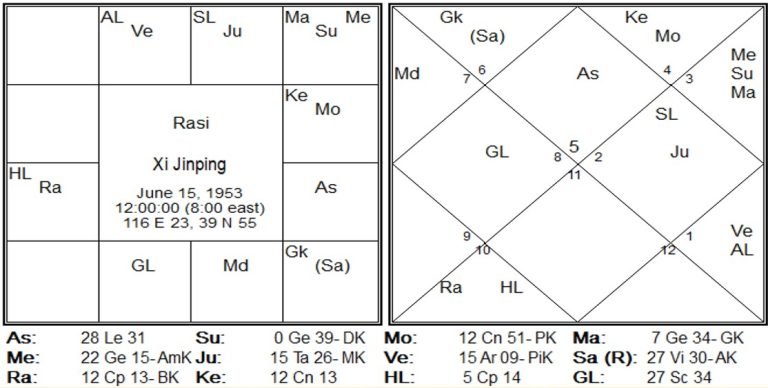
Analysts report that the reason China’s leader, Xi Jinping, has become so intensely autocratic and repressive is because he fears that what happened to the USSR will happen to his country. In 1989, Russia collapsed as provinces and religious cultures formed local governments of their own. What is truly fascinating is that Chinese politicians who knew Xi decades ago say they don’t recognize the man he’s become. Xi was born June 15, 1953 in Beijing, but we don’t know his birth time. However, just looking at planets in his birth chart, we know that Xi has two very distinctly different sides of his personality. Introspective and shy, as well as aggressive and powerful.
Xi’s introspective side comes from his Moon being conjunct with Ketu, within six degrees at the widest. Even without his birth time, we can see that at 12 noon on his day of birth the Moon was conjunct within less than 1 degree of Ketu. This means that if he was born at either 12:01 AM or 1159 PM, the furthest away the Moon could have been was about six degrees.
Xi’s aggressive and dominating side, comes from his Sun-Mars conjunction, within seven degrees. Thus, while Xi must manifest both sides of his personality, opposite though they are, it appears that nature is “using” Pluto’s transit of Capricorn, to bring out Xi’s aggressive side in order to achieve its goal of either autocratic rule or annihilation of government. Or both. Thanks, Pluto!
President Xi Jinping is now considered the most powerful leader China has seen since Chairman Mao Zedong died in 1976. He has gained so much power since taking office in 2012 that he managed to remove constitutional term limits so he can stay in power indefinitely. Unsurprisingly, the level of Chinese suppression has intensified tremendously. There are surveillance cameras and drones everywhere, millions upon millions, according to political news shows. There are said to be informers and spies all over the country, reporting suspicious or anti government activities.
More repressive and more Plutonian still, in 2020, under Xi Jinping’s rulership, Hong Kong, which had been promised continued autonomy and democracy, was suddenly denied its rights. Hong Kong is now completely under China’s thumb. Also, in December, 2021, a famous statue commemorating the Tiananmen Square massacre was removed from the grounds of The University of Hong Kong. The removal of ‘Pillar of Shame’ came as Beijing increasingly cracks down on political dissent, one of democracy’s cornerstones.
Further, and again perfectly fitting with Pluto’s destructive side, a cult of personality has arisen around Xi Jinping, where Chinese citizens are urged to “Study Xi” and no doubt study him appreciatively. There is even a Chinese game show where contestants compete to see who best understands Xi Jinping’s thinking. Photographs of Xi Jinping hang all over China: In homes, restaurants, malls, taxi cabs, etc. The now ‘forever leader’
(The Chinese constitution was last year amended to remove term limits for the country’s President), is being described the same way that most mainstream U.S. media label the Donald Trump phenomenon: “Cult of personality.”
Donald Trump, June 14, 1946 10:54 AM, Jamaica, New York, USA

On the American side, it seems Pluto has been using Donald Trump for similar purposes. As detailed in my ten page analysis of President Trump in the Famous Horoscopes chapter in Ancient Hindu Astrology for the Modern Western Astrology: Revised and Expanded 2020, Trump’s Hindu/Vedic birth chart is more powerful, by leaps and bounds, than any I’ve ever seen. And when I say leaps and bounds, I mean huge leaps and huge bounds. I’ve never seen a chart so extroverted, domineering, and overpowering. What is critical to understand, though, is that Donald Trump was, and still is, a man who is generally without serious political philosophies. During his campaign, his rivals kept declaring that Trump wasn’t even a true conservative. And they were right, he’s simply incredibly bossy and massively domineering by nature. He’s been a perfect instrument to help uproot the governmental and conventional structures symbolized by Pluto transiting Capricorn. Indeed, so many people voted for Trump not for his ideas and policies, but because they loved his contempt and indifference toward the powers that be, and all the institutions they represented.
EDITOR’S NOTE: Pluto is not shown in the represented chart. Pluto was at 16 degrees, 56 minutes Cancer or Karka in Trump’s birth chart.
It’s true that Trump was elected in 2016, four years before Pluto’s entrance into Capricorn, but consider these two salient facts: One, Autocratic leaders, seeing Trump’s methods prove so successful, began adopting his leadership style for their own benefit. If you think Trump had no bearing on the world’s ushering in authoritarian governments, think more carefully. For four years, other strongmen around the world followed his lead. Indeed, many such leaders could have been accused of political plagiarism.
Second, Donald Trump is still in power. Even after leaving office he still controls one of the two major political parties. Members of his party must pledge their fealty and allegiance, or face instant, total loss of political influence. He’s a failed ex-president (meaning one who lost his bid for reelection) who has managed to maintain phenomenal power. This is extraordinary! Nothing like it has ever occurred before in the United States.
Vladimir Putin, October 7, 1952, 9:30 AM; St. Petersburg, Russia.

Russia, another great power, has almost always lived under iron fisted rule. For this reason, it’s possible, though not certain, that their citizens might be spared any huge changes. Vladimir Putin took office in 2008 and time will tell whether he will become even more repressive and controlling in the next years. It’s also possible, however, that Russia could experience a Plutonian style collapse similar to what happened in 1989.
[NOTE: As this book goes to press, Vladimir Putin of Russia is demonstrating unbridled power by invading Ukraine.]
As depressing as these dark scenarios sound, remember that Pluto’s positive side is just as powerful and wonderful. Pluto’s positive side is a force of nature and sight to behold.
I can attest to this. According to a system called “Astrodines,” Pluto is the strongest planet in my Western chart, and despite all the pain it’s caused, I have benefitted tremendously from its influence. In my Western horoscope, Pluto is angular and it tightly sextiles (60 degree aspect) Neptune, the Sun, and Mercury, while also squaring my Moon and ascendant. Pluto has an oversized effect on my life, for which I am eternally grateful.
While the agony Pluto causes is sometimes enormous beyond belief, the rebirth afterwards is often magnificent. Between December 1979 and September 1981, Pluto transited my Sun and altered my life forever. The transit coincided with divorce and my father’s death, all in the space of less than 18 months. While the grief and heartache over these two events in such a short period of time are almost indescribable, the personal growth, progress, and evolution was astonishing.
Uranus, Neptune, and Pluto all represent different kinds of spirituality. Uranus is connected to metaphysical and intuitive ability, and living remarkably in the present; Neptune’s spirituality is about mysticism and openness to realms beyond the five senses. Pluto is the one known for “universal welfare.” Following Pluto’s transit of my tropical Libra Neptune, Sun, and Mercury (Neptune at 19 degrees; Sun 22 degrees; Mercury at 25 degrees), I was dramatically energized, revitalized, and brought face to face with power and creative energies that had remained hidden and dormant in me up to that time.
Pluto is the planet responsible for cellular regeneration, which is what facilitates the “rebirth” effect. I don’t lie when I say there was a James Braha personality before Pluto’s transits and a new, vastly more powerful one, afterwards. The earlier me was shy, fearful, and intensely repressed. And, like most people, I cared mainly about myself: My happiness, my personal evolution, my own personal enlightenment (an oxymoron, if there ever was one since enlightenment is the end of anything personal). When Pluto finished transiting over my three Libran planets, all I wanted was to become a positive influence in the world and to help others. I never again attended long meditation courses as I had during the previous seven or eight years. Instead, I began searching for a spiritual career where I could be of service. Pluto: Universal welfare.
Astrology is never absolute. When Pluto transits work, though, expect no less than spiritual death and rebirth. Expect major regeneration and renewal.
For example, when Pluto conjuncts a person’s Venus, any intensely harmful or unhealthy patterns that were negatively affecting the person’s love life may suddenly and dramatically surface to be healed. Pluto’s effects, as mentioned earlier, are often akin to lancing a boil or removing a tumor. What happens afterwards of course depends on the particular situation involved. However, when Pluto has had its way with Venus, the person’s love relationships will never be the same again. Those bonds will either be massively healthier or, if that’s not possible, they will end once and for all.
When Pluto’s second transit over my Sun coincided with my father’s death in January 1981, part of my rebirth was to intuitively sense that it was time for me to take his place, if you will. My father was a selfless man, and always helpful to others whenever possible. It was in late 1982, while still grieving from my father’s death, that I left for my first journey to India. There, I found my life’s purpose. As the years passed, after returning to India and then writing my first Jyotish book, I came to realize that, for some inexplicable reason, I could not have accomplished what I did or become what I have while my father was alive. Something in me had to die first. Pluto: Death and rebirth.
Regarding Pluto’s so far disastrous transit of Capricorn, remember that a wonderful regeneration and renewal of leadership and organizing societal principles are possible. Remember that Pluto’s last transits into Capricorn produced one of the greatest democracies on earth in 1776.
Perhaps because my focus in astrology has been on natal horoscope analysis, I have found using astrology for mundane predictions more challenging. Oddly, I’ve noticed that in my friends’ and clients’ lives negative predictions succeed distinctly more often than positive ones. My guess is that this is related to the fact that we live during the reign of Kali Yuga, the age of quarrel, the darkest of all yugas.
On the hopeful side, it is possible that when Pluto enters tropical Aquarius in 2023 and 2024 conditions could improve. Before getting too optimistic, however, remember what was mentioned in Sutra 29, Neither Zodiac, tropical (Western) or sidereal (Eastern) is the “Correct” One; They Are Simply Based on Different Concepts: The great astrologer/astronomer Ptolemy, who lived between 100 and 170 AD, used the tropical zodiac for analyzing peoples’ horoscopes, and the sidereal for mundane astrology (predictions concerning countries and weather events).
Final Note
As mentioned so many times in this book already, anyone who believes that Western astrology is only capable of predicting behavior and psychology, or that Uranus, Neptune, and Pluto should be ignored, or that the tropical zodiac is faulty, should re-read this sutra again. Slowly and thoughtfully. And, for anyone who thinks we can simply disregard Pluto just because the ancients ignored the outer planets (because they couldn’t be seen by the naked eye), it’s time to reconsider.
As taught in my other books, there are two different house systems, and both must be used in order to gain accuracy. The first is the older, more traditional method, where degrees are irrelevant. For example, any planet that sits five signs away from the ascendant sign is considered to be in the 5th house. Likewise, any planet three signs away from the ascendant occupies the 3rd house.
The other method is more modern, and is called the bhava chart. In the bhava chart, the ascendant degree is considered to be the middle of the 1st house. As such, if the ascendant degree is 25 degrees Leo, then any planet from 10 degrees Leo to 10 degrees Virgo will reside in the 1st house (and the ascendant ruler will be the Sun, ruler of the sign Leo). This is because houses are always 30 degrees in size (in both the natal and the bhava charts), and the ascendant degree is, as already mentioned, the middle of the 1st house in the bhava chart.
When obtaining Jyotish readings in India, it’s typical to find astrologers using either of the two house systems. For example, Santhanam, my first mentor, noted both systems, but emphasized the ancient one and taught me to do the same. However, my second teacher, P.M. Padia, told me that for the accurate results, both systems must always be used. His reasoning wasn’t philosophical, but practical. He always used what worked best and produced the most accuracy.
A good example of how the two house systems work together exists in my horoscope, where the ascendant is in a very early degree, 2 degrees Taurus. My Sun, which sits in 29 degrees of Virgo, is five signs away (always count inclusively) from my Taurus ascendant, and therefore considered to be in the 5th house in the ancient system. Because the 5th house rules the mind and because the Sun is the atmakaraka, or indicator of the soul, my life is a particularly mental and intellectual one. This was one of the first things my mentor, Padia, taught me during my studies. He said that whatever house holds the atmakaraka becomes a soul-connected realm.
[NOTE: In the Parasara system, the most popular one and the one taught in this book, the Sun is the atmakaraka in every chart. In the Jaimini system, the planet that occupies the highest degree gains atmakaraka status. Coincidentally, the Sun in my chart is atmakaraka in both cases, since it occupies a higher degree than all the other planets.
Incidentally, it’s true that the Jaimini system of using planetary degrees, from highest to lowest within any sign, for karakas, is also found in Brihat Parasara Hora Sastra. However, because so many classical texts were altered by translators, this reference must not be accepted uncritically. I was taught by the scholar R. Santhanam, that the karaka system originated in Jaimini astrology. And, authors Hart DeFouw and Robert Svoboda in Light on Life concur. About Jaimini karakas appearing in Parasara’s text they write, “This does not mean it is integral to Parashari [sic] Jyotish; it may have been a later addition.” DeFouw and Svoboda continue, “To determine the significators for relatives [siblings, mother, children, and others] by the Jaimini method and then to use them in Parashari [sic] to analyze relations causes inherent contradictions. It is as illogical to use Jaimini significators in Parashari aspects as it would be to use diesel fuel in a petrol engine.” (Light on Life, 1996 edition, page 94)]
However, in my bhava chart, the Sun occupies the 6th house, because with a 2 degree Taurus ascendant, the 1st house will extend from 17 degrees Aries to 17 degrees Taurus. The rest of the houses flow from there: The second house goes from 17 Taurus to 17 Gemini, the 3rd from 17 Gemini to 17 Cancer, and so on. Therefore, my Sun in 29 degrees of Virgo occupies the 6th house, rather than the 5th. So, I have a soul connection with health matters, healing techniques, and self improvement. It’s partly because of my bhava chart 6th house Sun that I’ve engaged in so many healing and self development courses during my life, which are mentioned throughout this book.
In 2019, when I gave a workshop at the Sedona Vedic Astrology Conference, I was stunned to learn how many students had never heard about the bhava chart. This is one of the most important and basic features of horoscope analysis, and if it is ignored, accuracy in charts with very late or very early degree ascendants will be dramatically off the mark in certain areas. Consider the case where a person has a 3 or 4 degree ascendant and a major malefic in a latter degree of the 6th house. Such a planet will function as both 6th and 7th house influences. For example, if the ascendant is 5 degrees Capricorn, while Saturn sits at 25 degrees of Gemini, then Saturn occupies both the 6th and 7th houses and divorce will be highly likely. There will positively be marriage problems.
Likewise, if the ascendant is 27 degrees Scorpio, while benefic Jupiter sits at 3 or 4 degrees Gemini (the 8th house from the ascendant), Jupiter will give both 8th and 7th house effects. Marriage will be favorable, lucky, and a source of great happiness. Any astrologer missing the bhava chart positive 7th house placement in this example will go astray. And, as I mentioned above, many astrologers unfortunately choose to use either the ancient system or the bhava. They must both be used to achieve the most accuracy.
Also, please note that planetary aspects (drishtis) must be used in the bhava chart as well. Thus, in the example above, Jupiter in both the 7th and 8th houses will aspect the 1st and 2nd houses. This is also critical. During the beginning days of study, using both the natal and the bhava charts may feel daunting. After all, it’s hard enough to analyze one horoscope. However, a huge part of the reason astrologers have trouble delineating the natal chart accurately is because some of the planets, and in certain cases many of them, are giving effects in two houses due to the bhava chart. Thus, using the bhava chart makes your job easier, not harder.
Finally, it is positively critical to use the bhava chart when trying to rectify a horoscope to find the correct ascendant. I dare say that if you’re not using the bhava chart in these situations, you shouldn’t bother trying. This is because, as already mentioned, the bhava chart creates a situation where a planet in a house may remain there even when changing the ascendant. In other words, while a planet in the 2nd house may go to the 3rd house when changing the ascendant in the ancient house system, that planet may stay in the 2nd house in the bhava chart. I can’t emphasize enough that you must use the bhava chart.
[NOTE: For those reading this who wonder how a birth chart can be rectified when a planet gives obvious results in two different houses, the answer is to use rulerships more than planets in houses. This is explained thoroughly in Sutra 79, How to Rectify an Ascendant That Sits On the Edge of a Sign.]
Regarding the question of which of two houses gets the most influence when a planet is affected by the bhava chart, that’s hard to know with certainty. However, the farther away from the ascendant degree a planet is, the more likelihood it will give more influence to the bhava chart house, rather than the one in the ancient system house. For example, looking at my chart with a 2 degree Taurus ascendant and a 23 degree Aries Moon, the Moon gives a 1st house effect (as well as 12th house) due to the Moon being close enough to the 2 degree ascendant. However, if, for example, my Moon was in 28 or 29 degrees Aries, it would be only 3 or 4 degrees away from the ascendant and would likely affect the 1st house more than the 12th.
As another example, my ascendant is in 2 degrees Taurus, while the Sun is in 29 degrees Virgo. The difference, degrees wise, is so big that the Sun will definitely have more of a 6th house influence than a 5th.

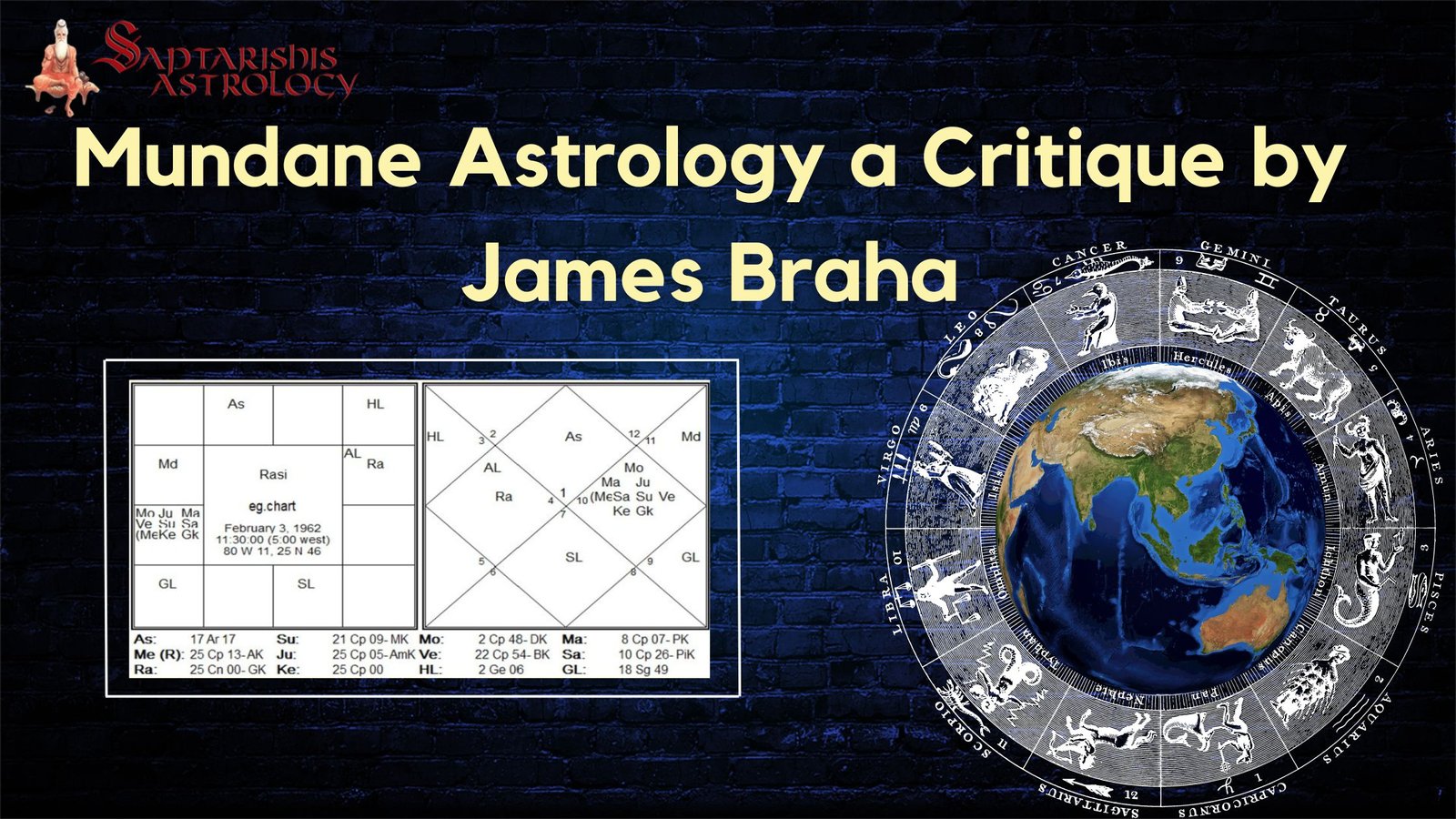

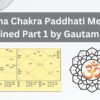
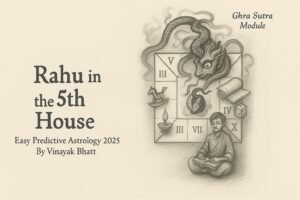
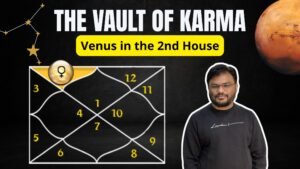
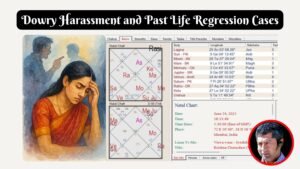


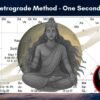
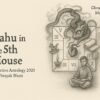


Leave a reply
You must be logged in to post a comment.